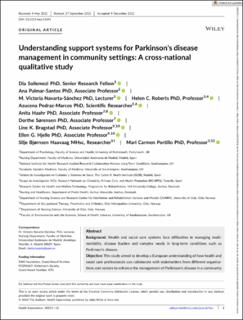| dc.contributor.author | Soilemezi, Dia | |
| dc.contributor.author | Palmar-Santos, Ana | |
| dc.contributor.author | Navarta-Sánchez, Maria Victoria | |
| dc.contributor.author | Roberts, Helen | |
| dc.contributor.author | Pedraz-Marcos, Azucena | |
| dc.contributor.author | Haahr, Anita | |
| dc.contributor.author | Sørensen, Dorthe | |
| dc.contributor.author | Bragstad, Line Kildal | |
| dc.contributor.author | Hjelle, Ellen Gabrielsen | |
| dc.contributor.author | Haavaag, Silje Bjørnsen | |
| dc.contributor.author | Portillo-Vega, Mari Carmen | |
| dc.date.accessioned | 2023-01-02T12:28:25Z | |
| dc.date.available | 2023-01-02T12:28:25Z | |
| dc.date.created | 2022-12-28T17:40:04Z | |
| dc.date.issued | 2022 | |
| dc.identifier.issn | 1369-6513 | |
| dc.identifier.uri | https://hdl.handle.net/11250/3040302 | |
| dc.description.abstract | Background
Health and social care systems face difficulties in managing multimorbidity, disease burden and complex needs in long-term conditions such as Parkinson's disease.
Objective
This study aimed to develop a European understanding of how health and social care professionals can collaborate with stakeholders from different organizations and sectors to enhance the management of Parkinson's disease in a community setting by identifying the existing gaps in this process and how people with Parkinson's disease and their family carers could benefit from these partnerships.
Methods
A mixed-methods sequential study was conducted in Denmark, Norway, Spain and the United Kingdom. The findings from the qualitative phase are presented. Individual semistructured interviews were analysed using Braun's and Clarke's thematic analysis. A meta-ethnography approach was used to analyse and synthesize cross-national findings.
Results
A total of 41 healthcare professionals and 39 stakeholders from different disciplines and sectors were interviewed in the four countries. The participants acknowledged a lack of awareness of available resources and poor communication between the different support systems in the management of Parkinson's disease. To promote multiagency collaborations, the participants highlighted the need to organize services along the Parkinson's disease journey, patient involvement and strategic involvement of carers in organizing resources and Parkinson's disease care pathways. According to the participants, the benefits from multiagency partnerships could lead to an enhanced continuity of care and specialized knowledge, mobilization of resources in the community, personalized support and improved access to services.
Conclusions
Policymakers are called upon to create formal structures that facilitate multisectoral collaborations to promote an integrated system of care for the management of Parkinson's disease in the community. To address this challenge, we propose five strategies showing how organizations can work together to optimize the use of resources and enhance the management of Parkinson's disease throughout the illness trajectory.
Patient or Public Contribution
Patient and Public Involvement groups made up of stakeholders, healthcare professionals, patients with Parkinson's disease and family carers participated in the design of the study, the development of the interview guides and the validation of the findings. | en_US |
| dc.language.iso | eng | en_US |
| dc.publisher | Wiley | en_US |
| dc.rights | Navngivelse 4.0 Internasjonal | * |
| dc.rights.uri | http://creativecommons.org/licenses/by/4.0/deed.no | * |
| dc.title | Understanding support systems for Parkinson's disease management in community settings: A cross‐national qualitative study | en_US |
| dc.title.alternative | Understanding support systems for Parkinson's disease management in community settings: A cross‐national qualitative study | en_US |
| dc.type | Peer reviewed | en_US |
| dc.type | Journal article | en_US |
| dc.description.version | publishedVersion | en_US |
| cristin.ispublished | true | |
| cristin.fulltext | original | |
| cristin.qualitycode | 1 | |
| dc.identifier.doi | 10.1111/hex.13691 | |
| dc.identifier.cristin | 2097842 | |
| dc.source.journal | Health Expectations | en_US |
| dc.relation.project | Norges forskningsråd: 299762 | en_US |

